外科学-心肺脑复苏2014-3
心肺脑复苏

外科学(第9版)
第一部分 基础生命支持
(2)高质量的胸外心脏按压方法 ➢ 施行胸外心脏按压时,病人必须平卧于硬板或地上,术者立于或跪于病人一侧 ➢ 按压部位在病人胸骨中下1/3交界处或两乳头连线中点的胸骨上 ➢ 将一手掌根部置于按压点,另一手掌根部覆于前者之上,手指向上方跷起 ➢ 两臂伸直,凭自身重力通过双臂和双手掌,垂直向胸骨加压 ➢ 每次按压后应使胸廓充分回弹,胸骨回到其自然位置 ➢ 按压间隙不要倚靠在病人胸壁上 ➢ 胸外按压频率100~120次/分,成人按压深度5~6cm ➢ 如果有2人以上进行心脏按压时,建议每2分钟(或5个按压呼吸周期)就交换一次
体外自动除颤
外科学(第9版)
二、高级心血管生命支持
意义:高级生命支持(advanced life support,ALS)是基础生命支持的延续,是以高质量的 复苏技术、药物和设备治疗争取最佳疗效和预后的复苏阶段,是生命链中的重要环节 内容:在持续CPR同时间隔2分钟除颤一次的基础上,着手连接氧气和心电监护,建立静脉通路 给予药物治疗,建立高级气道并监测呼气末二氧化碳,同时寻找和治疗引起心脏骤停的潜 在原因,力争恢复和维持自主循环
第二节
心肺脑复苏
重点难点
掌握 基础生命支持的流程和方法,除颤仪的应用
熟悉 心脏按压的原理,人工呼吸的原理,高级心血管生命支持的 内容,复苏后治疗的内容
了解 心肺脑复苏、脑复苏的概念,脑复苏的意义及处理原则
外科学(第9版)
心肺复苏(cardiopulmonary resuscitation,CPR)
3.液体与血管活性药物
外科学-心肺脑复苏

(二)高级生命支持
3.药物治疗
方法步骤
(2)利多卡因
• 可降低心肌应激性,提高室颤阈值,抑制心肌异位起搏 点,是目前治疗室性心律失常的首选药物。常用量为1~ 1.5mg/kg,缓慢静脉注射(2~3min),必要时可重复应 用,也可以2~4mg/min的速度静脉滴注,但要注意1h内最 大剂量不超过300mg。
• 其中以前三条最为重要
临床诊断
早期识别心跳骤停非常重要
专业人员应5~10秒内判断有无呼吸及大动脉搏动,即使10秒钟内 不能做出判断也应立即复苏,并启动急救医疗服务系统 临床判断应迅速、果断,切忌反复进行血压测量和心音听诊,以免 延误抢救时机
抢救过程
基本生命支持 高级生命支持 复苏后治疗
方法步骤
(一)基本生命支持
方法步骤
人工呼吸的先决条件
仰头提颏 法(最简单
有效)
仰头抬 颈法
开放 气道
托下颌法
(颈椎或脊 柱有损伤者)
(一)基本生命支持
方法步骤
人工呼吸(现场常用口对口、口对口鼻方法) 1.徒手人工呼吸:一手小鱼际置于患者前额并下压使其头部后仰,拇 指及食指捏闭患者鼻孔,另一手抬颈或提起下颌,用嘴唇完全包住患者 口(鼻),平静呼吸状态下用力吹入,吹气时间不小于1秒。
心肺脑复苏
目录
Conten
概述
心肺复苏(CPR):使心跳、 心肺复苏最终目的:中枢神 呼吸骤停的患者迅速恢复循 经系统功能恢复,因此也称 环、呼吸所采取的抢救措施。 心肺脑复苏(CPCR)。
心肺复苏是基础,脑复苏是关键
心血管疾病
• 心肌梗死最常见 • 冠心病、严重心律失常 • 脑出血、脑栓塞等
心脏骤停与心肺脑复苏ppt课件

电除颤的能量选择
• 单向波形除颤仪: 360J • 双向波形除颤仪: 200J
心脏骤停与心肺脑复苏
除颤步骤
① 打开电源 ② 粘贴电极板 ③ 选择能量 ④ 确认安全后按电击按钮
心脏骤停与心肺脑复苏
起搏治疗
• 对心搏停止患者不推荐使用起搏治疗。 • 对有症状的心动过缓,尤其是高度房室传导
阻滞发生在希氏束以下时立即起搏治疗。
心脏骤停与心肺脑复苏
第四环节:有效高级心血管生命 支持
专业急救人员到达现场后,通过建立高级 气道和用药进行的抢救治疗。
心脏骤停与心肺脑复苏
人工气道及机械通气
建立人工气道的目的: 维持血液充分氧合和清除二
氧化碳潴留
BLS和ACLS阶段应给患者100% 氧,使动脉血氧饱和度达最大化
心脏骤停与心肺脑复苏
始终保持气道开放 吹气时不能漏气 连吹2次,注意让病人出气 确保胸部升起并维持1秒 频率:成人10-12次/分,
儿童/婴儿12-20次/分
注意事项
心脏骤停与心肺脑复苏
牙关紧闭时如何进行人工呼吸?
口 对 鼻 呼 吸
心脏骤停与心肺脑复苏
人工呼吸
球囊面罩通气装置
心脏骤停与心肺脑复苏
心脏骤停与心肺脑复苏
判断意识
• 拍打双肩,凑近耳边大声 呼唤: “喂!你怎么了?”
• 如均无反应,则确定为 意识丧失
轻拍重喊
心脏骤停与心肺脑复苏
成人颈动脉搏动检查
中、食指横放颈部中 央,向气管一侧轻按 滑动2~3cm
时间<10秒 力度适中
心脏骤停与心肺脑复苏
呼救
意识丧失即为危险状态,需立即呼救
心脏骤停与心肺脑复苏
C -人工循环
心肺复苏
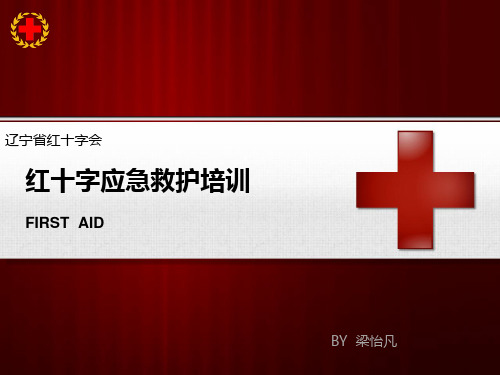
美国:每年心脏骤停患者情况
1,000 例/d
(1例/90s)
75% 发生于院外 20% 无前驱症状 95% 死于未及时的早期治疗
< 5% 存活
发病总数 350,000
人类猝死87.7%发生在医院以外, 没有医护人员参与抢救。 猝死人员有35 – 40 % 如经现场 及时进行心肺复苏,可以挽救生 命。 我国每年猝死人数近100万,其 中心脏性猝死近60万,平均每天 1000多人,居全球之首。
儿童“海姆立克”急救手法 如果是儿童(1~8岁)发生气管异物哽塞,其海姆 立克法要领和成人同,
若是小於1岁以下之婴儿,有呼吸道异物,则不可做 哈姆立克急救法,以免伤及腹腔内器官,应改为拍背 压胸法。方法为:一手置于婴儿颈背部,另一手置于 婴儿颈胸部,
婴儿呼吸道异物窒息急救方法
先将婴儿趴在大人前臂,依靠在操作者的大腿 上,头部稍向下前倾,在其背部两肩胛骨间拍背 5次,依患者年纪决定力量的大小。再将婴儿翻 正,在婴儿胸骨下半段,用食指及中指压胸5次 ,重覆上述动作直到异物吐出。
呼吸心跳骤停的表现
意识丧失
面色苍白 呼吸停止
二、及时呼救,启动救援系统
请周围人帮助,按需拨打急救电话。立即启动救 援医疗服务系统(EMS )
志愿者(救护员)立即通知场馆内医疗保障组
先1.5-3分钟的CPR 一旦除颤器准备就绪,就直接除颤
• 心脏除颤时仅做1次电击之后立即行CPR,每2分钟检查1次心律 • 认可1~8岁儿童使用体外自动除颤仪(AED) • 有条件的,1岁以下幼儿也可应用AED
在西方发达国家,院外抢救存活
率为2%~15%。在我国,不足 1%。
实施对象: 意识丧失;呼吸和心跳骤停
急
心肺复苏2014年国际新标准操作流程CPR
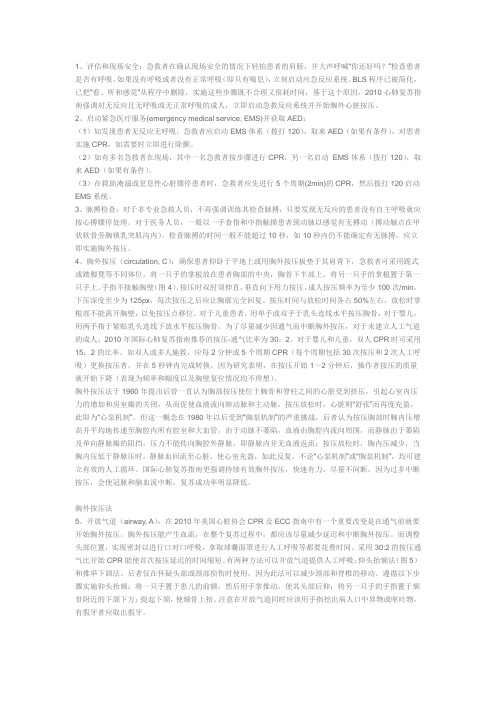
1、评估和现场安全:急救者在确认现场安全的情况下轻拍患者的肩膀,并大声呼喊“你还好吗?”检查患者是否有呼吸。
如果没有呼吸或者没有正常呼吸(即只有喘息),立刻启动应急反应系统。
BLS程序已被简化,已把“看、听和感觉”从程序中删除,实施这些步骤既不合理又很耗时间,基于这个原因,2010心肺复苏指南强调对无反应且无呼吸或无正常呼吸的成人,立即启动急救反应系统并开始胸外心脏按压。
2、启动紧急医疗服务(emergency medical service, EMS)并获取AED:(1)如发现患者无反应无呼吸,急救者应启动EMS体系(拨打120),取来AED(如果有条件),对患者实施CPR,如需要时立即进行除颤。
(2)如有多名急救者在现场,其中一名急救者按步骤进行CPR,另一名启动EMS体系(拨打120),取来AED(如果有条件)。
(3)在救助淹溺或窒息性心脏骤停患者时,急救者应先进行5个周期(2min)的CPR,然后拨打120启动EMS系统。
3、脉搏检查:对于非专业急救人员,不再强调训练其检查脉搏,只要发现无反应的患者没有自主呼吸就应按心搏骤停处理。
对于医务人员,一般以一手食指和中指触摸患者颈动脉以感觉有无搏动(搏动触点在甲状软骨旁胸锁乳突肌沟内)。
检查脉搏的时间一般不能超过10秒,如10秒内仍不能确定有无脉搏,应立即实施胸外按压。
4、胸外按压(circulation, C):确保患者仰卧于平地上或用胸外按压板垫于其肩背下,急救者可采用跪式或踏脚凳等不同体位,将一只手的掌根放在患者胸部的中央,胸骨下半部上,将另一只手的掌根置于第一只手上。
手指不接触胸壁(图4)。
按压时双肘须伸直,垂直向下用力按压,成人按压频率为至少100次/min,下压深度至少为125px,每次按压之后应让胸廓完全回复。
按压时间与放松时间各占50%左右,放松时掌根部不能离开胸壁,以免按压点移位。
对于儿童患者,用单手或双手于乳头连线水平按压胸骨,对于婴儿,用两手指于紧贴乳头连线下放水平按压胸骨。
2014心肺脑复苏

心脏骤停的定义
心脏骤停的定义,而从不同的临床角度出发, 心脏骤停的定义也不完全相同。
WHO规定:发病或受伤后24小时内心脏停搏 ,即为心脏骤停。
美国AHA为冠心病患者心脏骤停所作的定义是 :冠心病发病后1小时内心脏停搏,即为心脏骤停 。
Cecil内科学第十六版则规定:任何心脏病患者 或非心脏病患者,在未能估计到的时间内,心搏 突然停止,即应视为心脏骤停。
1、短暂的碱中毒,使氧解离曲线左移,减少 血红蛋白中氧的释放,加重组织的缺氧;
2、电解质平衡紊乱,降低游离钙和非游离钙 之比,使血清中钾离子进入细胞内,诱发恶性 心律失常,并产生高血钠,增加血浆渗透压;
3、碳酸氢钠本身可直接抑制心脏功能,降低 儿茶酚胺的活性;
4、碳酸氢钠在体内分解产生二氧化碳。
除颤
建议
无反应,没有呼吸或不能正常呼吸(仅仅是喘息) 10s内未扪及脉搏(医务人员) C→A→B >100次/分 >5cm
保证每次按压后胸廓回弹;2min交换一次 仰头提颏法(医务人员怀疑外伤:推举下颌)
30:2
单纯胸外按压 呼吸:8-10次/分;与胸外按压不同步
大约每次呼吸1s;明显胸廓隆起 尽快连接并使用AED;尽可能缩短电击前后的胸外按
加150mg快速静注,继之1mg/min 静滴6h,后0.5mg/min静滴至最大剂 量2g/d
(4)碳酸氢钠
很长时间以来一直作为心肺复苏时的一线 用药,其用药目的主要是纠正组织内酸中 毒。但现在的观点认为,在心跳呼吸骤停 早期,主要是由于呼吸停止所继发的呼吸 性酸中毒,如过早给予碳酸氢钠则可引起 不利反应。其原因主要为以下几点:
2014心肺脑复苏
心肺脑复苏术(CPCR)是抢救心脏呼 吸骤停及保护和恢复大脑功能的复苏技 术,主要用于复苏后能维持较好心肺脑 功能及能较长时间生存的病人。
心肺脑复苏
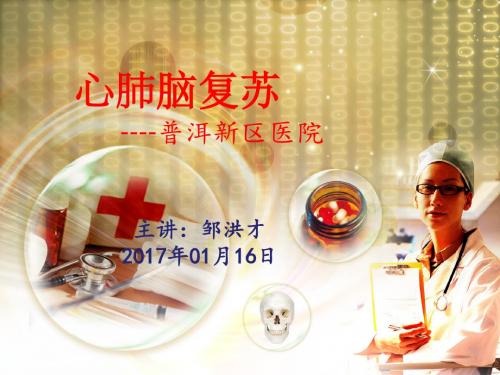
心搏骤停虽然只有几分钟,复苏后的多器官功能障碍却 可持续数小时以至数天,这是组织灌流不足导致的后果, 也称为心搏骤停后综合征。 临床上表现为代谢性酸中毒、心排血量不足、肝肾功能 障碍、急性肺损伤、急性呼吸窘迫综合征、DIC等
.为防止心搏骤停后发生缺血缺氧性脑病气采取的措施。 .脑复苏的主要任务是防治脑水肿和颅内压升高。
1
基本生命支持(BLS)
高级生命支持(ALS)
2
3
复苏 复苏后治疗( 后治疗(PCAC PCAC) )
一
基本生命支持(vasic life suooirt,BLS)
又称初期复苏或心肺复苏,是心搏骤停后挽救 病人生命的基本急救措施。胸外心脏按压和人 工呼吸(包括呼吸道的管理)是BLS的主要措 施。
对于非专业人员来说,如果发现有人突然神志消失或晕厥,可轻 拍其肩部并大声呼叫,如无反应(无回答、无活动),没有呼吸 或有不正常呼吸(如喘息),就应立即判断已经发生心脏停搏, 立即启动EMSs,以争取时间获得专业人士的支持和取得电除颤器。 即使是专业人士在10秒钟内还不能判断是否有脉搏,也应该立即 开始CPR,如果有两人或者两人以上在急救现场,一人立即开始 胸外按压,另一人打电话启动EMSs。
1、低温治疗:冰帽、冬眠疗法;
2、促进脑血流灌注:脱水、低温、糖皮质激素仍是现 今防治脑水肿和降低颅内压的主要措施;在脱水过程中应 适当补充胶体液以维持血管内容量及血浆渗透压;适当的 血液稀释有利于改善脑血流灌注;
3、药物治疗:脑细胞保护剂,钙通道阻滞剂、氧自由 基清除剂、糖皮质激素等。
력脑复苏的药物治疗
2
尽早开始CPR
1.心脏按压 (1).胸外心脏按压 有心泵机制和胸泵机制两种说法,但无论机 制如何,只要正确操作,即能建立暂时的人工循环,动脉血压可 达80-100mmHg,足以防止脑细胞的不可逆损害。 (2).开胸心脏按压 对中心静脉压和颅内压影响较小,因而增 加心肌和脑组织的灌注压和血流量,有利于自主循环的恢复和脑 细胞的保护。对于胸廓畸形、胸外伤、多发肋骨骨折、心脏压塞 等病人,应首选开胸心脏按压。胸外心脏按压效果不佳并超过10 分钟者,只要具备开胸条件,应采用开胸心脏按压。 2.人工呼吸 机械通气。 包括呼吸道的管理,徒手人工呼吸,简易人工呼吸,
外科学总论》考试题库(附答案)

外科学总论》考试题库(附答案)1.较易出现三低现象(低温、低白细胞、低血压)的全身性感染的致病菌是什么?A。
革兰氏阴性杆菌 B。
革兰氏阳性球菌 C。
无芽胞厌氧菌 D。
真菌 E。
以上都不是。
2.手术区皮肤消毒的范围应该包括手术切口周围多大范围的区域?A。
5cm B。
10cm C。
15cm D。
20cm E。
25cm。
3.T波高而尖是哪种电解质异常的心电图表现?A。
低钾血症B。
高钾血症C。
低钙血症D。
高钙血症E。
低镁血症。
4.代谢性酸中毒最明显的表现是什么?A。
疲乏、眩晕 B。
呼吸深快,呼出气带有酮味 C。
心率加快,血压偏低 D。
腱反射减弱或消失 E。
以上都不是。
5.治疗等渗性缺水后应该补充什么?A。
Na+ B。
Mg2+ C。
Ca2+ D。
K+ E。
Cl-。
6.休克病人应该采用什么体位?A。
平卧位 B。
半坐卧位 C。
侧卧位 D。
15°~30°头高脚低斜坡卧位 E。
头部和躯干抬高20°~30°,下肢抬高15°~20°卧位。
7.行肝叶切除的病人,术后出现切口血肿,未化脓,则该病人切口愈合情况应记录为:A。
Ⅰ/甲 B。
Ⅱ/甲 C。
Ⅲ/甲 D。
Ⅰ/乙 E。
Ⅱ/乙。
8.诊断休克的依据是什么?A。
舒张压<60mmHg,脉压<20mmHg B。
舒张压<60mmHg,脉压<30mmHg C。
收缩压<90mmHg,脉压<20mmHg D。
收缩压<90mmHg,脉压<30mmHg E。
以上都不是。
9.正常成年男性的基础代谢率是多少?A。
10kcal/kg B。
15kcal/kg C。
20kcal/kg D。
25kcal/kg E。
30kcal/kg。
10.脓性指头炎切开引流应该采用什么麻醉方式?1.局部浸润麻醉、指神经阻滞、臂神经丛阻滞、表面麻醉、基础麻醉是常见的麻醉方式。
2.破伤风最先受累的肌群是表情肌。
3.真性肿瘤包括皮样囊肿、表皮样囊肿、皮脂腺囊肿和腱鞘囊肿。
心肺脑复苏 (2)
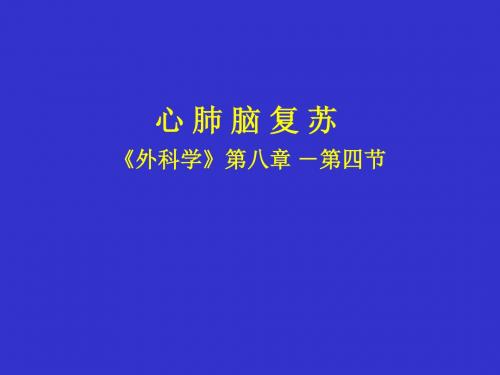
• The optimal technique for controlling the airway and ventilating the lungs during CPR • Efficient ventilation and protect the airway from aspiration.
• 无效的心输出量
• 四种形式:
– (1). Ventricular fibrillation VF
– (2). Ventricular tachycardia VT – (3). Asystole – (4). Electromechanical dissociation EMD
• pulseless electrical activity PEA
心肺脑复苏
《外科学》第八章 -第四节
概 述:
• 心肺复苏 Cardiopulmonary Resuscitation, CPR
• CPR 是针对呼吸,心跳停止所采用的抢救措施,即以人工 呼吸代替患者的自主呼吸,以心脏挤压形成暂时人工循环并 诱发心脏的自主搏动。
• 心肺脑复苏Cardiopulmonary Cerebral Resuscitation,
除颤方法
• Early ECG monitor to discover VF • Precordial thump 心前区重击 • The first set of three sequence DC shocks:
– 1. 200 J
• minimal myocardial damage, adequate to achieve success in most recoverable situations; decreases the thoracic impedance, thus increasing the amount of energy from the second DC shock.
心脏骤停与心肺脑复苏教学设计

创新教育科技创新导报 Science and Technology Innovation Herald1351 课程定位心脏骤停与心肺脑复苏是《急危重症护理学》的一个重要章节,是护士执业考试的重要内容,也是临床护士必备的操作技能。
我国急救知识的普及相对较晚,护理教育者应该利用有限的课堂教学资源,增强学生急救意识和应急应变能力,让第一现场的目击者与时间赛跑抢夺生命。
本章内容共4学时(理论2学时,实验2学时)。
在进行课程之前,教师要仔细研究学生对本节课程知识点的储备情况,帮助教师在进行教学设计时正确把握学习活动的详略,提高学习活动的针对性和有效性。
2 学情分析本课程开设于第四学期,学生具备一定的分析问题和解决问题的能力,即将进入实习岗位,有强烈的求知欲望。
学生已系统学习基础护理学、健康评估等内容,能够熟练应用护理程序采集病史,会进行基本的护理技术操作,为本次内容学习作了铺垫。
但个别学生,基础差、底子薄、学习积极性不高。
因此教学形式多样化,做到因材施教,拓宽学生的思路,增强学生求知欲。
3 教学目标目标是课堂教学的行动指南,教学目标制定的正确、具体与否,直接反映出教师对教材的理解情况。
教学目标的制定,不能全盘照搬参考书,要思考细化教学目标,提高单位时间的教学效率。
3.1 知识目标掌握心脏骤停的临床表现,基础生命支持的ABC步骤和注意事项。
3.2 能力目标能够把所学的理论知识尽快地转换为护理实践能力,运用评判性思维评估急救对象的病情,采取行之有效的急救措施。
3.3 素质目标学生必须具备高度的责任心、慎独严谨的工作作风、较高的团队合作精神、良好的心理素质。
4 教学过程设计4.1 理论教学(1)导入新课。
突出病例教学,课前选取典型临床真实病例,结合病例整合知识,将教学内容贯穿到病例分析之中。
引导学生思考什么情况下实施人工呼吸,胸外按压的标准和心肺复苏有效指征是什么等?带着问题开始新课的学习。
(2)讲解新课。
①通过复习提问的方式了解同学们对心脏骤停的概念、原因、类型、临床表现与诊断的掌握情况。
外科学1.8 心肺脑复苏

BLS
Circulation:建立有效的人工循环
循环支持 又称人工循环,是指用人工的方法通过 增加胸膜腔内压或直接挤压心脏推动血液循环的方 法。
分为:胸外心脏按压 胸内心脏按压
BLS
胸外心脏按压:病人仰卧在硬板或平地上, 头与心脏处于同一平面。急救者跪于病 人一侧,两臂伸直,双手交叉,手指上 翘,以自身重力通过掌根部垂直按压。
ALS
气
简
管
易
内
呼
插
吸
管
器
口咽通气道 口咽通气道
插管喉镜 插管喉镜
为了获得最佳肺泡通气和供氧,或需要行机械通气治疗者,应施行气 管内插管。而对于不适宜气管内插管者,可施行气管切开术以保持呼 吸道的通畅。
ALS
以人工呼吸器或呼吸机进行更有效的机械通气
(二)循环功能的支持与监测 (三)药物治疗
给药途径
心肺脑复苏
外科学教研室
复苏是研究使心跳呼吸停止而处于临床濒死期的病人重新获得生命 的急救措施。
心肺复苏(CPR)心肺复苏是针对呼吸、心搏骤停所采取的紧急医 疗措施,以人工呼吸代替病人的自主呼吸,以心脏按压形成暂时的 人工循环并诱发心脏的自主搏动。
心跳、自主呼吸恢复
循环稳定
CPR
Cardio-pulmonary Resuscitation
▲ 2.尽早启动紧急医疗服务系统
▲ 3.尽早电除颤
BLS
▲ (二)基本方法 ▲ 1.初期复苏 该阶段的主要操作步骤是:C→A→B
。 ▲ C(circulation)指迅速建立有效的人工循环; ▲ A(airway)指保持呼吸道通畅; ▲ B(breathing)指进行有效的人工呼吸。 ▲ 以现场胸外心脏按压和口对口(鼻)人工呼吸为
2014-11徒手心肺复苏术

1
判断循环
• 观察面色及四肢 有无抽动,若未 触及动脉搏动, 立即进行心肺复 苏,时间≤6秒。
心肺复苏—胸外心脏按压
●按压方法:
按压时上半身前倾, 腕、肘、肩关节伸 直,以髋关节为支 点,垂直向下用力, 借助上半身的重力 进行按压。
心肺复苏—胸外心脏按压
• 3、按压深度
≥5cm
注:压下与松开的 时间基本相等
谢谢聆听!
现场徒手心肺复苏术
(CPR)
陆川县人民医院 吕斌
一、评估
环境
病人
1、判断 现场
2、判断 意识
在病员耳旁大声呼 唤并轻拍双肩,观 察患者自主呼吸是 否正常,时间≤ 4秒
3、呼救
呼叫他人打 120电话,并 嘱咐回来帮忙。 时间≤3秒。
4、急 救
1、摆放复苏体位(去 枕平卧位),解开上衣, 松开裤带。 2、清理呼吸道:头向 一侧,取下活动假牙, 清除口鼻异物或分泌物
二、操作步骤
二、操作步骤
1 2
3
判断循环
胸外心脏按压
口对口人工呼吸
1
判断循环
判断循环:触摸颈动 脉搏动 1、颈动脉位置: 气 管与颈部胸锁乳突肌 之间的沟内。 2、方法:一手食指 和中指并拢,置于患 者气管正中部位,男 性可先触及喉结然后 向一旁滑移约2-3cm, 至胸锁乳突肌内侧缘 凹陷处。
心肺复苏—胸外心脏按压
时间就是生命
• • • • • • 心跳停止3秒钟 ----黑朦 心跳停止5-10秒钟----晕厥 心跳停止15秒钟 ----昏厥或抽搐 心跳停止45秒钟 ----瞳孔散大 心跳停止1-2分钟 ----散大瞳孔固定 心跳停止4-5分钟 ----大脑细胞不可逆损害
争分夺秒
外科学复习题
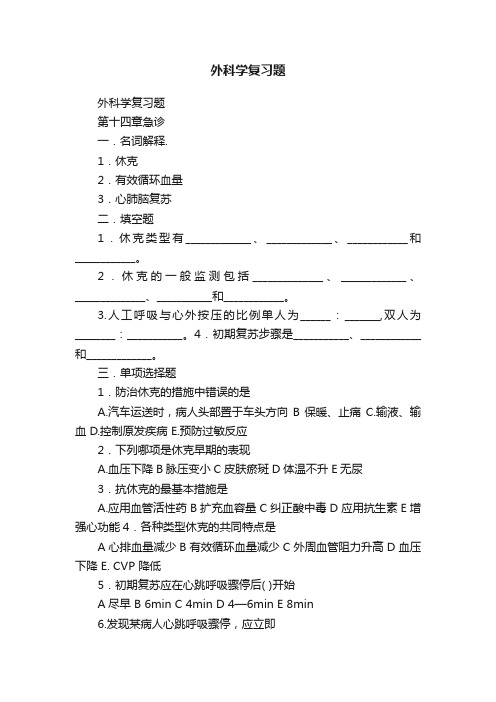
外科学复习题外科学复习题第十四章急诊一.名词解释.1.休克2.有效循环血量3.心肺脑复苏二.填空题1.休克类型有_____________、_____________、____________和____________。
2.休克的一般监测包括______________、_____________、______________、___________和____________。
3.人工呼吸与心外按压的比例单人为______:_______,双人为________:___________。
4.初期复苏步骤是___________、____________和_____________。
三.单项选择题1.防治休克的措施中错误的是A.汽车运送时,病人头部置于车头方向B保暖、止痛C.输液、输血 D.控制原发疾病 E.预防过敏反应2.下列哪项是休克早期的表现A.血压下降B脉压变小C皮肤瘀斑D体温不升E无尿3.抗休克的最基本措施是A.应用血管活性药B扩充血容量C纠正酸中毒D应用抗生素E增强心功能4.各种类型休克的共同特点是A心排血量减少B有效循环血量减少C外周血管阻力升高D血压下降 E. CVP 降低5.初期复苏应在心跳呼吸骤停后( )开始A尽早 B 6min C 4min D 4—6min E 8min6.发现某病人心跳呼吸骤停,应立即A 吸氧B测量血压C做心电图检查D事实初期复苏E应用复苏药物7.胸外心脏按压与人工呼吸次数比双人是A 1:1B 2:1C 3:1D 4:1E 5:18.判断口对口人工呼吸是否有效的主要依据A 吹入时阻力的大小B 胸廓明显起伏C瞳孔是否缩小D口唇紫绀是否有改善E 心跳是否改善四.问答题1.休克早期有哪些临床表现?2.休克的治疗原则是什么?3.休克的病因有哪些?4.如果进行初期复苏?第十五章体液平衡失调一.名词解释1.渗透压2.低钾血症3.代谢性酸中毒二.填空题1.静脉补钾应注意______________ ____________ ____________和____________。
心肺复苏理论及技能考试试题

2014年ICU三基考核系列-心肺复苏理论考试姓名: 得分:一、选择题(每小题3分):1、心跳骤停紧急处理原则中,下列哪项是错误的( )A、迅速开始人工呼吸B、开始胸外按压前需待心电图确诊C、立即开放静脉输液通道D、立即开始胸外按压E、准备好电击除颤2、2010心肺复苏指南中胸外按压的频率为( )A、至少80-100次/分B、至少100次/分C、至少 120次/分D、至少60-80次/分3、2010心肺复苏指南中单或双人复苏时胸外按压与通气的比率为( )A、 30:2B、 15:2C、 30:1D、 15:14、对成人进行口对口吹气时,吹气的频率为( )A、10-12次/分钟B、20-24次/分钟C、5-6次/分钟D、 12-20分钟5、 心肺复苏指南中胸外按压的部位为( )A、 双乳头之间胸骨正中部B、 心尖部C、 胸骨中段D、 胸骨左缘第五肋间6、 成人心肺复苏时胸外按压的深度为( )A 、至少胸廓前后径的一半 B、 至少3cm C、 至少5cm D、 至少6cm7、在成人心肺复苏中,潮气量大小为( )A、500-600mlB、 600-700mlC、400-500mlD、800-1000ml8、使用单向波除颤仪,电击能量选择为( )A、 200JB、 300JC、 360JD、 150J9、 成人心肺复苏时打开气道的最常用方式为( )A 、仰头举颏法 B、 双手推举下颌法 C、 托颏法D、 环状软骨压迫法10、现场救护的“生命链”中第二个环节是( )A、早期心肺复苏B、早期高级心肺复苏C、早期心脏电除颤 D 、早期高级生命支持11、现场进行徒手心肺复苏时,伤病员的正确体位是( )A、侧卧位B、仰卧在比较舒适的软床上C、仰卧在坚硬的平面上D、 俯卧位12、现场对成人进行口对口吹气前应将伤病员的气道打开( )为宜A、60度B、120度C、90度D、75度13、刘某,在海中游泳时不甚溺水,被送到急诊室,查体:神志不清,口流海水,呼吸微弱,心率45/ min,血压90/60mmHg,医生不在场,护士处理正确的是( )A、立即呼叫医生等待医嘱B、立即头偏一侧,吸出口腔异物,吸氧C、立即心外按压D、立即心电监护E、先测生命体征14、简单而迅速地确定心脏骤停的指标是( )A、呼吸停止B、血压下降C、瞳孔散大D、意识消失,无大动脉搏动E、呼之不应15、胸外心脏按压术哪项是错误的( )A、按压比放松的时间长一倍B、按压部位在胸骨中下1/3交界处C、按压部位的定位先确定胸骨下切迹D、按压频率为100/min以上E、按压与放松时,重叠的掌根不能离开胸骨定位点16、应用简易呼吸器进行人工呼吸的频率为多少( )A、12—16次/分B、 10一12次/分C、 12一16次/分D、 8一10次/分E、 12一16次/分17、病人心肺复苏后,脑复苏的主要措施是( )A、维持有效的循环B、确保呼吸道通畅C、降温和脱水疗法D、加强基础护理E、治疗原发疾病18、成人胸外心脏按压的操作,下列哪项是错误的( )A、病人仰卧背部垫板B、急救者用手掌根部按压C、按压部位在病人心尖区D、使胸骨下半段及其相邻的软骨下降5cm以上E、按压要有节律,每分钟至少100次19、患者突然发生心跳骤停,仅一人在场应首先( )A、心内注射B、氧气吸入C、先胸外按压,再清理呼吸道、打开气道行口对口呼吸D、立即报告医生E、立即建立静脉通道20、以下哪种心电图表现在心搏骤停病人中最常见? ( )A、心—电机械分离B、室颤C、房颤D、心室停顿E、室速21、某患者患冠心病14年,因心前区疼痛症状加重来医院就诊,在诊室门口护士见到该病人突然晕倒,意识丧失,颈动脉搏动消失,呼吸停止,瞳孔散大,此时护士应该立即进行的抢救是( )A、吸氧B、开放气道C、人工呼吸D、静脉输液E、除颤22、CPR行5个循环后重新评估心跳呼吸,不正确的是( )A、无呼吸无心跳,持续CPRB、无呼吸无心跳,等待使用AEDC、有呼吸无大动脉搏动,心脏按压D、无呼吸有大动脉搏动,人工呼吸E、有呼吸有大动脉搏动,准备运送23、BLS时,如有条件需要尽早进行的是( )A、早呼120B、早心外按压C、早电击除颤D、早建立静脉通路E、早高级生命支持24、怀疑颈髓损伤时,首选打开气道的方法是( )A、仰头抬颏法B、双手推举下颌法C、压舌板D、开口器E、气管插管25、对于呼吸、心跳骤停的伤病员现场救护的黄金时间是( )A、4分钟B、10分钟C、15分钟26、现场心肺复苏包括C、A、B三个步骤,其中C是( )A、胸外按压B、人工呼吸C、开放气道27、心跳停止时间是指( )A、循环停止到重建人工循环的时间B、循环停止到心脏复跳的时间C、发现心跳停止到重建人工循环的时间D、发现心跳停止到心脏复跳的时间E、以上都不是28、急诊室送来一位无脉电活动,心率30次的病人,已经给予气管插管,持续的胸外按压,你接下来应给予( )A、肾上腺素 1mg 静脉B、200J 电除颤C、异丙肾上腺素 1mg静脉D、准备经皮起搏29、在心肺复苏过程中,应尽量减少中断胸外按压,中断胸外按压的时间( )A、不超过10秒钟B、不超过5秒钟C、不超过20秒钟D、不超过1分钟E、不超过30秒钟30、心肺复苏时急救者在电击除颤后应( )A、立即检查心跳或脉搏B、先行胸外按压,在5组(约2分钟)心肺复苏后再进行心跳检查C、立即进行心电图检查D、调节好除颤仪,准备第二次除颤E、静脉推注胺碘酮。
心脑肺复苏术的名词解释

心脑肺复苏术的名词解释
心肺脑复苏(CPCR)通常是指心跳骤停后进行的一系列恢复生命活动的及时、规范、有效急救措施的总称,主要用于心跳骤停导致的全身血循环中断、呼吸停止、意识丧失等所采取的急救措施。
心肺脑复苏术主要强调维持脑组织的血液灌流,争取脑功能的完全恢复。
心肺脑复苏术主要是通过心肺复苏(CPR)的方式,即人工呼吸、心脏按压、电击除颤等,针对呼吸系统、心跳停止等所采取的抢救措施,必要时需注射药物如肾上腺素、阿托品等进行复苏。
心肺脑复苏术的目的在于脑复苏,脑功能的恢复如自理能力、智力、工作能力等的恢复,是复苏成败的关键。
任何为抢救生命而采取的医疗措施均可称为“复苏”,如对心跳骤停、严重心律失常、呼吸停止、窒息、休克、高热、中毒、严重创伤等的救治均属于广义复苏的范畴。
通常所说的“复苏”是狭义的,即心肺复苏(Cardiopulmonary resuscitation, CPR)是指病人心跳呼吸突然停止时所采取的一切抢救措施。
由于脑复苏的重要性日益为人们所重视,而且脑复苏是心肺复苏的根本目的,仅有心跳、呼吸而无脑功能的人,对社会及家庭都是十分沉重的负担。
以上内容仅供参考,如需获取更多信息,建议查阅相关文献或咨询专业医生。
外科学第八章重症监测治疗与复苏

心肺脑复苏
• 心肺脑复苏可分为三个阶段:初期复苏
(basic life support,BLS)、后期复苏 (advanced life support,ALS)和复苏 后治疗(post-resuscitation treatmen-t, PRT)。
• 心肺脑复苏成功的关键是时间。在心脏停
搏(cardiac arrest)后4分钟开始初期复 苏、8分钟内开始后期复苏者的恢复出院率 最高。
心肺脑复苏
初期复苏
• 初期复苏(basic life support,BLS)是
呼吸、循环骤停时的现场急救措施,主要 任务是迅速有效地恢复奥运会器官(特别 是心脏和脑)的血液灌流和供氧。
• 初期复苏的任务和步骤可归纳为ABC:A
(airway)指保持呼吸道顺畅,B (breathing)指进行有效的人工呼吸,C (circulation)指建立有效的人工循环。
重症监测治疗
• 三、肾功能的监测与保护 • 监测肾功能的动态变化不仅能评价肾脏本
身的功能状态,而且在评估全身的组织灌 注、体液平衡状态及心血管功能等方面都 有重要价值。尤其在重危病人中,肾功能 的监测更为重要。
重症监测治疗
• 四、水、电解质和酸碱平衡的调控 • 危重病人,因某种病因或病理生理改变,
心肺脑复苏
• 心脏按压可分为胸外心脏按压和开胸心脏
按压两种方法。
• 心脏按压有效时可以触及颈动脉或股动脉
搏动。胸外心脏按压较常见的并发症是肋 骨骨折。
心肺脑复苏
后期复苏
• 后期复苏(advanced life support,ALS)
是初期复苏的继续,是借助于器械和设备、 先进的复苏技术和知识以争取最佳疗效的 复苏阶段。
《外科学》心肺脑复苏 ppt课件
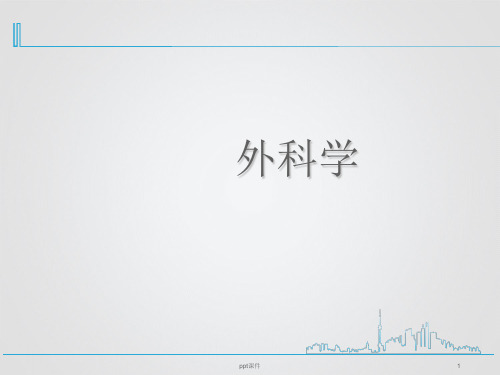
ppt课件
23
第7章 心肺脑复苏
➢ 胸外心脏按压所产生的血流,远不能满足脑和心肌的需要。 ➢ 开胸心脏按压更容易刺激自主心跳的恢复,增加心肌和脑
组织的灌注压和血流量,有利于自主循环的恢复和脑细胞 的保护。 ➢ 适用于禁忌胸外心脏按压或胸外按压无效者。
外科学
ppt课件
1
心肺脑复苏
Cardiopulmonary Cerebral Resuscitation
ppt课件
2
精品资料
• 你怎么称呼老师?
• 如果老师最后没有总结一节课的重点的难点,你 是否会认为老师的教学方法需要改进?
• 你所经历的课堂,是讲座式还是讨论式? • 教师的教鞭
• “不怕太阳晒,也不怕那风雨狂,只怕先生骂我 笨,没有学问无颜见爹娘 ……”
环恢复
ppt课件
21
第7章 心肺脑复苏
开胸心脏按压 (open chest compression)
➢ 更好地维持血流动力学稳定; ➢ 由胸外心脏按压改为胸内按压可使CI、冠脉及大脑的灌
流得到改善:CI可达正常者的52%,冠脉血流量可达正常 者的50%以上,脑血流量可达正常者的60%以上。 ➢ 不仅更容易激发自主心跳的恢复,且对CVP和颅内压的 影响较小,有利于自主循环的恢复和脑细胞功能的保护。
ppt课件
6
第7章 心肺脑复苏
心室纤颤
ppt课件
7
第7章 心肺脑复苏
生存链
(Chain of Survial)
1992年 AHA 提出
2010年 AHA 提出
1.尽早识别心脏骤停并启动EMSs
2.尽早开始CPR,着重于胸外按压
有无神志消失或
3.尽早电除颤
- 1、下载文档前请自行甄别文档内容的完整性,平台不提供额外的编辑、内容补充、找答案等附加服务。
- 2、"仅部分预览"的文档,不可在线预览部分如存在完整性等问题,可反馈申请退款(可完整预览的文档不适用该条件!)。
- 3、如文档侵犯您的权益,请联系客服反馈,我们会尽快为您处理(人工客服工作时间:9:00-18:30)。
Algorithm for treating Cardiac arrest
Signs of cardiac arrest
* Sudden deep unconsciousness * Absent carotid and femoral pulse * Dilated pupils * Ashen cyanosis * Apnoea or gasping
ponents of resuscitation from cardiac arrest are ABCDE
Airway Breathing Circulation Drugs Electrical therapy
Management of cardiac arrest
Basic Life Support, BLS Advanced Life Support, ALS
Cardiopulmonary Resuscitation
Electrical Therapy
* Defibrillaion and Cardioversion
Defibrillation: shock VF/ pulseless VT (200J,200J to 300J, 360J ) up to 3 times
Basic Life Support, BLS
Cardiac arrest (Patterns of ECG)
* Ventricular fibrillation (VF) * Ventricular tachycardia with no cardiac
output * Asystole * Electromechanical dissociation (EMD)
in children, and then allow to return to its normal position
Lie on a hard surface (patient) Use weight of the upper body Arm straight to reduce fatigue Heels of hands crossed Fingers clear of chest Apply pressure over the low half of the sternum
* External cardiac massage * Airway and artificial ventilation * Operator expired-air resuscitation * Bag and mask ventilation
Advanced Life Support, ALS
Airway Breathing Circulation Drugs Electrical therapy
Algorithm for treating Cardiac arrest
Primary ABCD Survery A Airway: Open the airway B Breathing: provide positive-pressure ventilations C Circulation: give pressions
VENTRICULAR ASYSTOLE
Total absence of ventricular activity Absolutely flat baseline (except possible P waves)
Consider possibility of fine ventricular fibrillation and need for defibrillation
6)‘Tables’(Drug OD, accidents)
7)Tamponnade, cardiac 8)Tension pneumothorax 9)Thrombosis, coronary 10)Thrombosis, pulmonary (embolism)
Check responsiveness Activate emergency response system Call for help
Epinephrine (0.5-1 mg I.V.) every 5 minutes
Atropine (1 mg I.V.) every 5 minutes Pacemaker (external or transvenous)
Drugs
* Epinephrine * Vasopressin * Amiodarone * Lidocaine * Sodium bicarbonate
Mouth-to-mask: bag-valve-mask bag-valve-endotracheal tube
C: CIRCULATION
External Chest Compression Intravenous Access Dysrhythmia Recognition Drug Administration Defibrillaion and Cardioversion
Defibrillation as soon as possible and repeated a necessary Epinephrine (0.5-1 mg I.V.) every 5 minutes Lidocaine (1 mg/kg I.V.)
Rate 100-220/min Rhythm regular of irregular P waves usually not present plexes appear like premature ventricular contractions Usually associated with dramatic decline in blood pressure and cardiac output
Consider most frequent causes
1)Hypovolemia 2)Hypoxia 3)Hydrogen ion-acidosis 4)Hyper-/Hypokalemia, other metabolic 5)Hypothemia
Consider most frequent causes
Cardiopulmonary Resuscitation
Contents
* Consider most frequent causes * Signs of cardiac arrest * Management of cardiac arrest * Management of brain damage
Epinephrine (0.5-1 mg I.V.) every 5 minutes Atropine (1 mg I.V.) every 5 minutes Pacemaker (external or transvenous)
Electro-Mechanical Dissociation, EMD
equipment and drugs
A: AIRWAY
Head-tilt and Chin-lift Jaw-trust without Head-tilt------whenever a
cervical spine injury is suspected Heimlich Maneuver
arrhythmias durinain damage
General measures * Prevention of hypoxaemia and hypercapnia * Depression of cough and swallowing Specialised treatment * Hyperventilation * Osmotherapy * Steroids * Barbiturates and CNS depressants * Calcium antagonists
Basic Life Support: life support without the use of special
equipment
Cardiopulmonary Resuscitation
Advanced Cardiac Life Support: life support with the use of special
External cardiac massage
Lie on a hard surface (patient) Use weight of the upper body Arm straight to reduce fatigue Heels of hands crossed Fingers clear of chest Apply pressure over the low half of the sternum The sternum is depressed 4-5cm in adult,2-4cm
Dysrhythmia Recognition Drug Administration
Disorganized ventricular electrical activity Rate too rapid and disorganized to count Rhythm irregular No discernible P waves of plexes Irregular undulations in electrocardiograph baseline Always results on no effective cardiac output
Key points for treating Cardiac arrest
Check responsiveness Activate emergency response system Call for help
ponents of resuscitation from cardiac arrest are ABCDE
